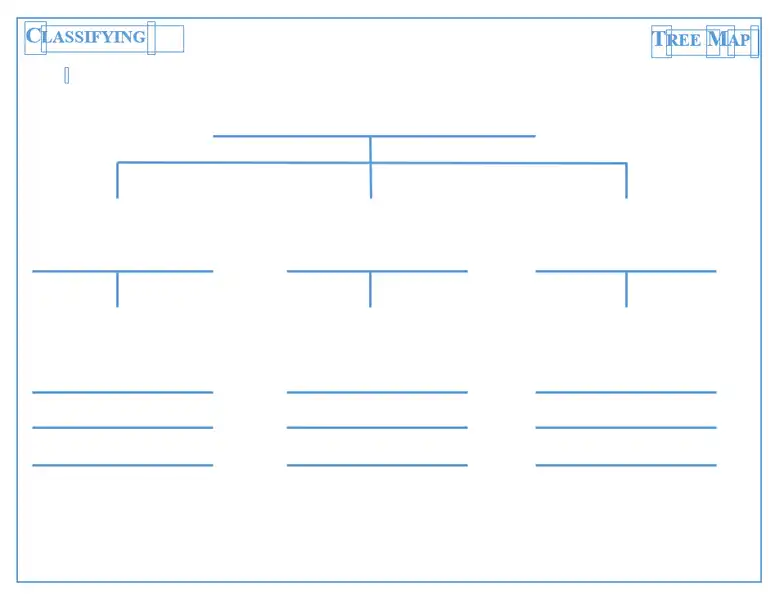A tree map template is a powerful methodological tool that can be used for planning, tracking, and reporting. A tree map is a graphical representation of data that organizes information by branches and leaves. This allows users to easily see relationships between different pieces of data while also helping to visualize patterns easily.
You should use a tree map template for many reasons. You may be trying to track the progress of a project or analyzing customer behavior. Whatever your needs, a suitable template is available online or on disk that will let you get the job done quickly and efficiently.
This article will explore the basics of creating your tree map template and show you some of its benefits. We’ll also give you tips on using it more effectively so that your data analysis runs as smoothly as possible.
What is a tree map?

A tree map is a visual representation of data that can be used to plan, track and report on various aspects of your business.
A tree map can help you see the relationships between the different data points and understand how they relate. It also allows you to centralize and control the information in your database. Additionally, it can assist you in complete knowledgeable decisions about where to allocate resources and focus your efforts.
The following template provides an overview of what a tree map looks like and how it is useful for planning, tracking, and reporting:
This simple diagram shows five sets of data:
- Customer accounts receivable (CAR)
- Product inventory levels
- Delivery times for orders placed by customers outside the company’s geographical boundaries
- Order product prices across geographies
- Sales commissions paid out by managers within certain regions
The dotted line connecting each data set represents a relationship or connection between them. By using this visualization tool, business analysts can quickly identify any correlations or patterns among these disparate pieces of information.
Why use a tree map?
- A tree map is a powerful visual tool that can assist you schedule, tracking, and reporting your business.
- A tree map helps you visualize your data. The layout of the trees makes it easy to see how different pieces of information relate to one another.
- A tree map helps you communicate your findings. The colors in the leaves indicate what type of information is inside them, making it easy for others to understand what you’ve found.
- A tree map can assist you in creating more profitable decisions by delivering a snapshot of your current situation and future possibilities. By understanding where you are right now and where you want to go, Tree Maps allows businesses to take the first steps toward getting there!
Benefits of using a tree map template
A tree map template can be used to understand how clients interact with your company. The advantage is tree map template includes the following:
- Improved clarity – Tree maps are visually appealing and easy to use, making it easier for you to see where problems or opportunities exist in your business at a glance.
- Increased understanding – By drawing connections between different areas of your business, you can gain deeper insights into how they work together and their role in customer interactions.
- Enhanced decision-making – With an improved overview of all aspects of your operation, you’ll be able to create more knowledgeable decisions about where to focus resources.
What are the different types of trees in a tree map?
A tree map is a great way to visualize your data and see relationships between different pieces of information. A tree map can be used for planning, tracking, and reporting.
There are three types of trees in a tree map: nodes, links, and edges.
- Node: Nodes represent individual items or entities in your dataset. They typically have properties like name, ID, or category. Links connect nodes so you can see the relationship between them. An edge connecting two nodes represents a link between those two items/entities.
- Link: Links represent an indirect connection between two nodes that doesn’t show the path linking them directly (like a road might). Edges indicate how specific data instances relate to each other (in terms of keys or values). For example, suppose you create an edge representing employee IDs linked with their corresponding salary amounts for the month. In that case, all employees who received at least one paycheck during that month will appear as links in the treemap with green lines connecting their IDs to their salaries.
- Edge: Edges represent direct connections between two nodes that don’t necessarily show the path linking them (think of it as points on a graph). This type of edge is useful when you want to display only certain aspects of data related to an edge (for example displaying only addresses associated with companies ).
How do you add data to your tree map?
To get started, choose one of our templates and fill out the necessary fields. You can add as many records as you want to your tree map, duplicate records for increased accuracy, and make it responsive or scale well across different devices. Once your data is entered and formatted the way you desire, click “Publish” to share your tree map with others.
Adding data to a tree map is easy with our templates. Select one of our ready-made designs, enter the relevant information into each field, and publish it online for others to access. Our trees are responsive and will display correctly on any device – from desktop computers to mobile phones – so you can always be up-to-date with all of the latest developments in your industry.
How do you print your tree map?
A tree map is a perfect tool if you’re looking for an effective way to plan, track and report your business growth tree map is like a diagram of all your business branches with their respective colors coded accordingly. This type of diagram can be printed using a wide range of printing methods, making it easy to fit into any space in your office.
The beauty of the tree map is that it can be customized to fit your specific needs. For example, if you want to see which areas of your business are most productive or popular, you can assign different colors to these regions. You also have the option to add notes related to each branch, such as statistics or goals that need to be met in that particular area.
Printing out a tree map isn’t just an effective way of planning; it’s also an excellent way to track progress over time. By tracking how each region has performed relative to others throughout the year, you can identify where changes need to occur for your business to rank its desired industry rankings once again.
Tips for using a tree map template
The tree map template can be used to plan, track and report your business. Here are five tips that will help you get the most out of this valuable tool:
- Use the tree map template to plan your progress and measure success. By understanding where you stand today and where you want to be tomorrow, you can make better decisions about what actions to take next. The tree map also allows for comprehensive tracking of key performance indicators (KPIs) so that you know how well your strategies are working.
- Track changes over time using the tree map template. This information can be useful in assessing whether new initiatives or changes within your organization have impacted overall performance or customer satisfaction.
- Customize the tree map template to meet specific needs. For example, if reporting is a priority for you, add additional fields for data entry at different points in time (such as monthly reports). Or, if strategy development is one of your main goals, include fields for ideas generation and discussion forum participation.
- Make use of charts and graphs to visualize data efficiently. Tree maps allow easy visualization of large amounts of data while retaining readability; charts make it easy to compare periods or investigate correlations between metrics.
- Share Tree Map with others! Sharing templates helps colleagues become more familiar with them quickly, which leads to improved decision-making.
Conclusion
Thank you for reading. We hope this comprehensive blog post has provided you with everything you need about tree maps. As we mentioned in the introduction, a tree map is an excellent way to organize and track your marketing efforts. Following the simple steps in this blog post, you’ll create a powerful and effective template to help you stay on top of your business goals. Thank you for taking the time to read!

